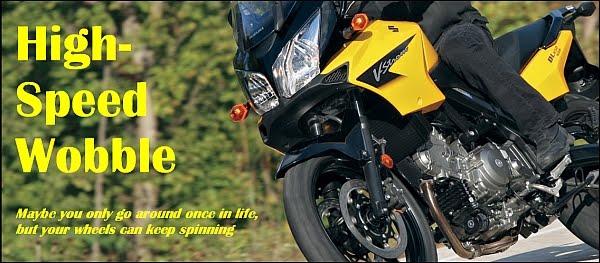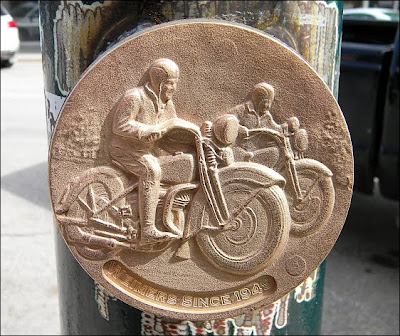When Mary, my beloved and long-suffering wife, who has tolerated my motorcycle adventures, suggested I really should visit Carhenge, I didn't want to disappoint her. She grew up in Nebraska and has a keen appreciation for Cornhusker culture, especially its whimsical expressions.
Carhenge isn't just a fanciful recreation of the iconic and prehistoric engineering feat erected in 3100 B.C. in England. No, it's more. There are also sharks, dinosaurs and giant daisies all made out of pieces of American cars, vintage 1950s and 60s.

A steel shark rises out of the fertile soil of western Nebraska.
To get there, I headed west from Gordon and then south to Alliance, a town of 9,000 with a flair for marketing. Formerly dubbed Grand Lake, despite the absence of a body of water deserving that name, the town got its current name thanks to the superintendent of the railroad that arrived in 1888. G.W. Holdredge said a simple, one-word name beginning with a letter close to the beginning of the alphabet would be better for business.

Carhenge, the creation that put Alliance, Neb., on the map.

The so-called "real" Stonehenge. If they'd had cars back in the day, they probably wouldn't have used rocks.
There were no crowds at Carhenge when I arrived nor anyone charging admission. A metal farm building, the "Pit Stop" visitor center and gift shop, anchored one end of the dirt parking lot, which opened into a field filled with weeds and, ... ah, sculpture. A tractor pulling a liquid fertilizer wagon worked the adjoining field.

A vintage, mid-50s Cadillac forms a graceful cross-piece.
According to the official Carhenge website, "38 automobiles were placed to assume the same proportions as Stonehenge with the circle measuring approximately 96 feet in diameter. Some autos are held upright in pits five feet deep, trunk end down, while those cars which are placed to form the arches have been welded in place. All are covered with gray spray paint. The honor of depicting the heel stone goes to a 1962 Caddy."
Wikipedia notes: "Other works have been built in the surrounding area of the sculpture."

Other works built in the area don't include the tractor on the right. Yet.
According to the story, "Carhenge was built as a memorial to Reinders' father who once lived on the farm where Carhenge now stands. While relatives were gathered following the death of Reinders' father in 1982, the discussion turned to a memorial and the idea of a Stonehenge replica was developed. The family agreed to gather in five years and build it. The clan, about 35 strong, gathered in June 1987 and went to work. They held the dedication on the Summer Solstice in 1987, with champagne, poetry, songs and a play written by the family."

Gray primer sprayed on the cars unifies the work.
Stonehenge is a place of pilgrimage for neo-druids, and for others of pagan or neo-pagan beliefs. While I was there, Carhenge was mostly a place of pilgrimage for groups of motorcyclists and folks in RVs stopping for a laugh and to take pictures.

Visitors are dwarfed by the enormous work of art.
OK, so much for whimsy. After stopping in Alliance for a sausage McMuffin with egg and a senior coffee, I was off toward Scottsbluff to visit Chimney Rock, the other Nebraska "must see," according to Mary.
"It's on the Nebraska state quarter," she said, leaving no room for argument.

Chimney Rock is a National Historic Site, one of the most recognizable landmarks for pioneers on the Oregon, California and Mormon trails.
I missed Chimney Rock on my first pass through Scottsbluff a few days before but I agreed to return to check it out, since Mary explained that it was Nebraska's equivalent to Hawaii's Diamond Head -- a revered icon.
It does get one's attention, rising vertically for 300 feet out of grasslands, which a herd of Angus was diligently harvesting.

Flanman reflects on his image in a window at the Chimney Rock visitor center.
Many pioneers travelling west reported they carved their names or initials into the rock's soft sandstone, but these have been erased by erosion. The rock was taller and thicker in those days, according to historical records, but time rain and wind have gradually worn it down.

From another angle, the wear and tear of erosion is apparent.

The state quarter celebrates the monument.
It was a busy morning, but leaving Chimney Rock I had a lot of ground to cover. I doubled back to Alliance to take NE 2 through the Sand Hills to Bertrand, Neb. -- journey's end. The wind was howling from the west, but I was headed due east, so it wasn't a bother, yet.
The Sand Hills are 23,000 square miles of dune-like mounds of grass-covered sand that sit atop the Ogalala Aquifer, 85 percent of which is untouched natural habitat that has never been plowed. Between the dunes are many shallow natural ponds and wetlands. Most of towns along NE 2 are tiny and unincorporated, joined together by the highway and the busy railroad, where 100-car trains carry coal from Wyoming mines to cities to the east.
For me, the challenge was to stay alert and on course as he KLR droned its way through the dunes on the gently curving two-lane highway. On this Sunday afternoon there was almost no other traffic as we passed the laden freights moving east and the empties speeding west for another load. I stopped in Mullen for a sandwich and a Monster energy drink and again in Thedford to refuel.
I decided to head south on US 83 at that point after checking my watch and how far I had to go before nightfall. Good move.

Nebraska's Sand Hills sit on a huge body of underground water.
Turning to the south, the wind cut across the road, now out of the east. I shifted my weight and leaned out to the left side of the bike to balance the steady breeze and brace for gusts. It was 66 miles to North Platte -- about an hour of wrestling with the crosswind. As I neared the city, a huge black storm cell towered above it. Turning east on I-80, I'd be running away from it.
In nearly seven weeks on the road, I'd gotten wet only a few times. There was a two-hour dousing between Waco and Austin, Texas, a snow shower coming over the pass into Flagstaff, another heavier snow shower in Monarch Pass, Colorado, and a few minutes of downpour riding from the motel to dinner in Sturgis, S. Dak. That was all, but it appeared I needed to get indoors soon or there would be a good soaking.
Bertrand, my wife's hometown, was 82 miles away, but I had a tailwind again and the weather gods were patient. I arrived at her dad's farm covered with dead bugs but five minutes ahead of the thunderstorm that had been stalking me from North Platte.
You honestly haven't seen a real thunderstorm till you've seen one in Nebraska.
The ride was over.
Now it's time to write it up, think about it and try to record what it all meant.




















































